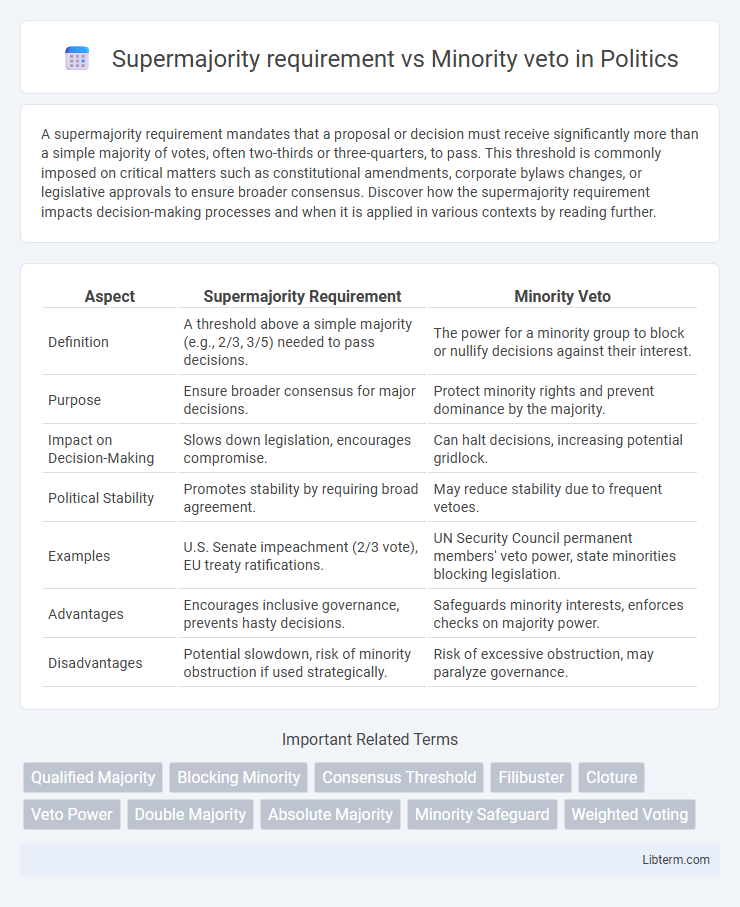A supermajority requirement mandates that a proposal or decision must receive significantly more than a simple majority of votes, often two-thirds or three-quarters, to pass. This threshold is commonly imposed on critical matters such as constitutional amendments, corporate bylaws changes, or legislative approvals to ensure broader consensus. Discover how the supermajority requirement impacts decision-making processes and when it is applied in various contexts by reading further.
Table of Comparison
| Aspect | Supermajority Requirement | Minority Veto |
|---|---|---|
| Definition | A threshold above a simple majority (e.g., 2/3, 3/5) needed to pass decisions. | The power for a minority group to block or nullify decisions against their interest. |
| Purpose | Ensure broader consensus for major decisions. | Protect minority rights and prevent dominance by the majority. |
| Impact on Decision-Making | Slows down legislation, encourages compromise. | Can halt decisions, increasing potential gridlock. |
| Political Stability | Promotes stability by requiring broad agreement. | May reduce stability due to frequent vetoes. |
| Examples | U.S. Senate impeachment (2/3 vote), EU treaty ratifications. | UN Security Council permanent members' veto power, state minorities blocking legislation. |
| Advantages | Encourages inclusive governance, prevents hasty decisions. | Safeguards minority interests, enforces checks on majority power. |
| Disadvantages | Potential slowdown, risk of minority obstruction if used strategically. | Risk of excessive obstruction, may paralyze governance. |
Introduction to Supermajority Requirements and Minority Veto
Supermajority requirements mandate a higher threshold of votes, typically two-thirds or three-fourths, to approve key decisions, ensuring broader consensus and preventing narrow majorities from controlling outcomes. Minority veto powers grant a smaller faction the ability to block proposals, protecting minority interests by requiring their explicit consent for certain actions. Both mechanisms balance decision-making authority, with supermajority emphasizing collective agreement and minority veto prioritizing minority protection.
Historical Evolution of Supermajority and Minority Protections
The historical evolution of supermajority requirements and minority veto protections reflects a balance between majority rule and safeguarding minority interests in decision-making processes. Supermajority rules have roots in ancient governance, designed to prevent rash decisions by requiring a higher threshold for approval, while minority veto powers emerged to ensure dissenting groups could block proposals threatening their core rights. Over time, these mechanisms evolved within constitutional frameworks to protect political stability and prevent tyranny of the majority.
Defining Supermajority: Concepts and Thresholds
A supermajority requirement mandates a higher-than-simple majority vote, often set at two-thirds or three-fourths, to approve significant decisions, ensuring broader consensus and protecting minority interests. This threshold varies depending on the context, such as constitutional amendments, corporate bylaws, or legislative procedures, reflecting the balance between decisive action and stability. Unlike a minority veto, which grants a small group the power to unilaterally block proposals, supermajority rules emphasize collective agreement while still enabling substantial minority influence.
Understanding the Minority Veto: Power and Purpose
The minority veto grants a smaller group within a decision-making body the power to block actions or proposals, ensuring protection against decisions that could harm minority interests. Unlike the supermajority requirement, which demands a higher threshold of approval, the minority veto specifically empowers minorities to prevent changes they find detrimental. This mechanism balances power by safeguarding against majority dominance while fostering consensus-driven governance.
Advantages of Supermajority Requirements
Supermajority requirements enhance decision-making stability by preventing abrupt changes that could arise from simple majority rule, ensuring broader consensus. This mechanism reduces the risk of minority obstruction that often accompanies minority veto powers, promoting more efficient governance. By requiring a higher threshold, supermajority rules foster collaboration and legitimacy in legislative and corporate settings.
Pros and Cons of Granting a Minority Veto
Granting a minority veto protects the interests of smaller groups by preventing decisions that could harm their rights or interests, promoting fairness and inclusivity in governance. However, this power can lead to decision-making gridlock, slowing down processes and potentially empowering obstructionist tactics. Balancing the minority veto is crucial to avoid undermining majority rule while safeguarding minority protections.
Supermajority Requirement vs Minority Veto: Key Differences
Supermajority requirement mandates a higher threshold, often two-thirds or three-quarters, for approval, ensuring broader consensus in decision-making processes compared to a simple majority. Minority veto grants a smaller group the power to block decisions, providing protection against majority dominance but potentially causing deadlock. Key differences include the balance between inclusive agreement in supermajority rules and decisive minority protection in veto rights, impacting legislative efficiency and minority influence.
Impact on Decision-Making and Governance
Supermajority requirements elevate the threshold for approval, ensuring broader consensus and reducing risks of arbitrary decisions in governance but can slow down the decision-making process. Minority veto powers empower a smaller group to block proposals, protecting minority interests but potentially leading to deadlock and stalled governance. Balancing these mechanisms impacts organizational efficiency, fairness, and the ability to implement timely policies.
Real-World Examples: Supermajority and Minority Veto in Action
Supermajority requirements, such as those in the U.S. Senate where a 60-vote threshold is needed to close debate, ensure broader consensus and prevent hasty legislation. Minority veto power is evident in the United Nations Security Council, where any of the five permanent members can block resolutions through a veto, protecting national interests but sometimes stalling collective action. Both mechanisms balance majority rule with minority protection, influencing decision-making efficiency and political negotiation outcomes.
Evaluating Which Mechanism Suits Modern Democracies
Supermajority requirements promote broad consensus by requiring a high threshold of approval, which can prevent hasty or divisive decisions in modern democracies. Minority veto power ensures protection of minority interests but risks legislative gridlock and inefficiency in decision-making processes. Evaluating these mechanisms involves balancing stability and inclusivity while considering political context, institutional design, and the need for effective governance.
Supermajority requirement Infographic

 libterm.com
libterm.com